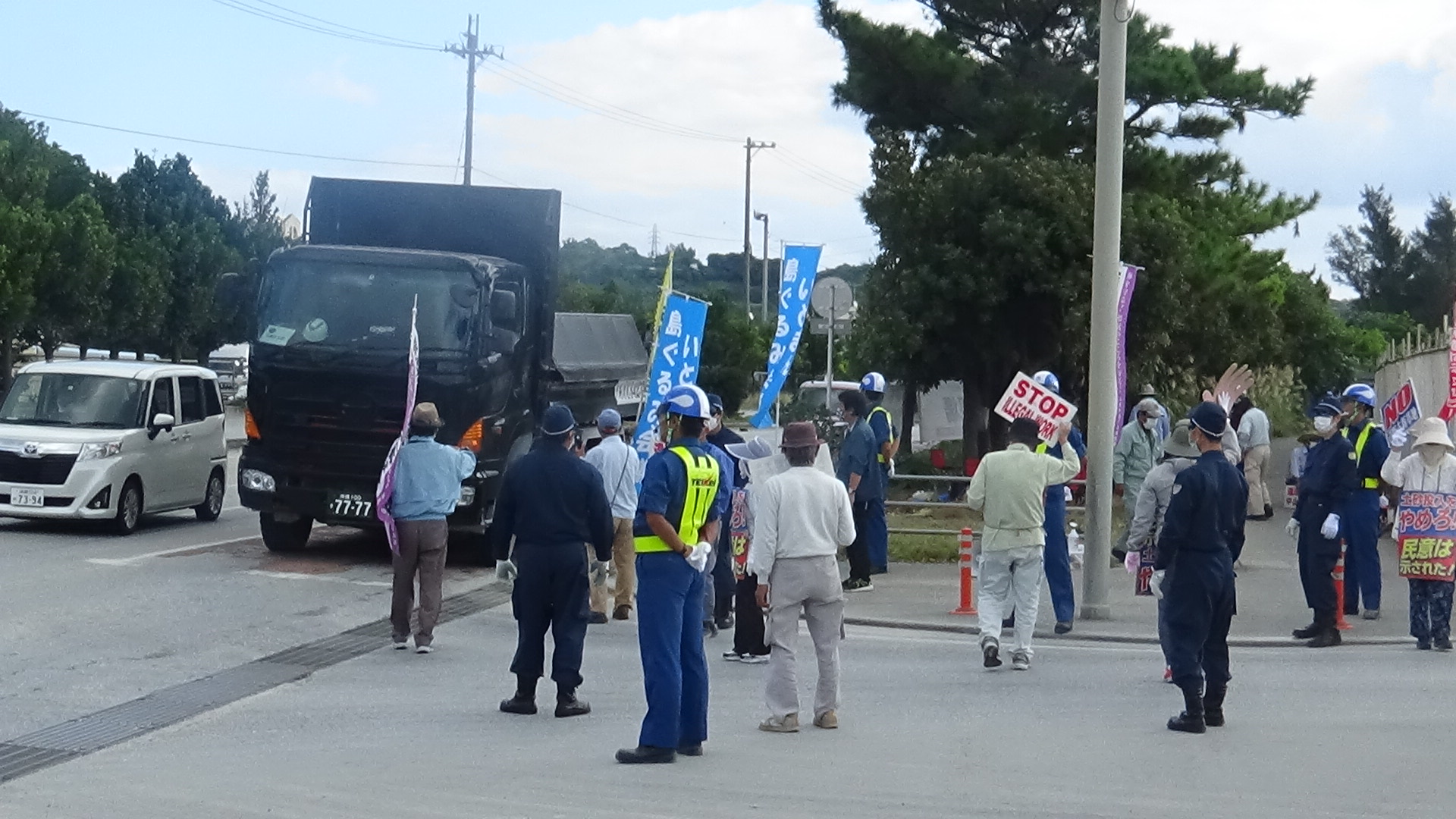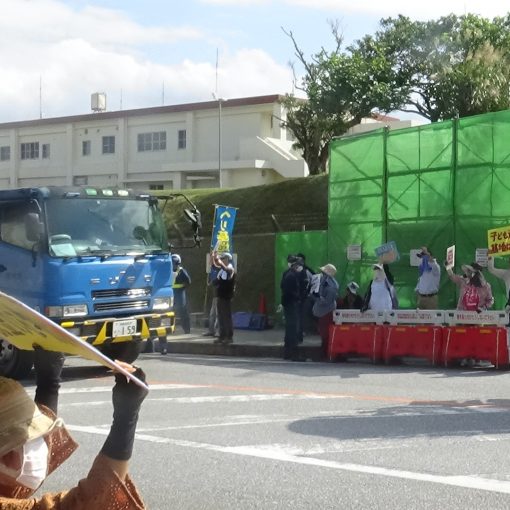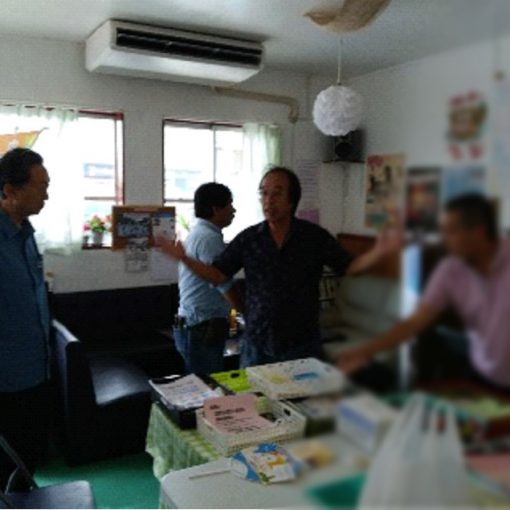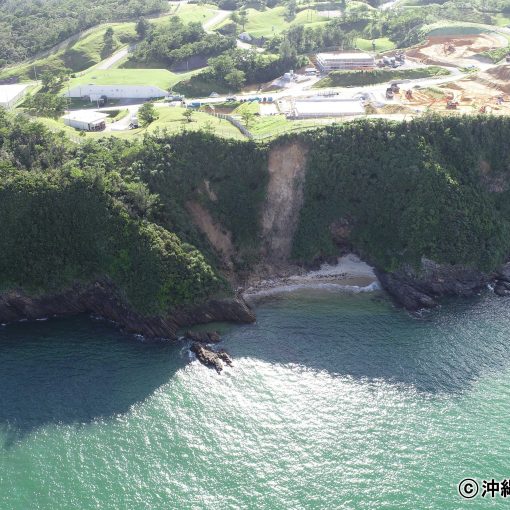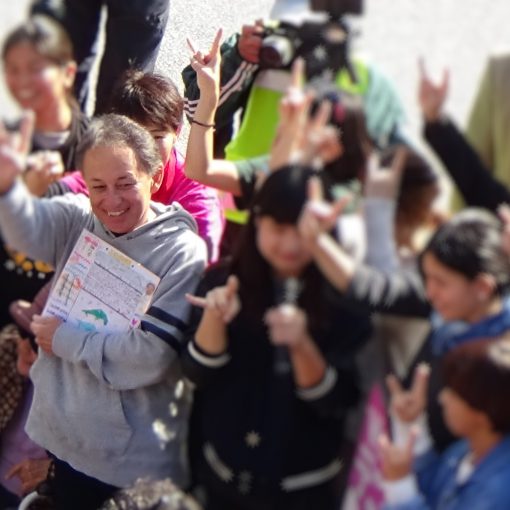On Nov 24, thirteen citizens filed a claim to the Public Safety Commission. They also submitted a written inquiry to the Okinawa Police Headquarters, protesting against the excessively long time traffic restriction and the use of the protesters’ names without an honorific by a riot police leader, H, at the Awa Pier entrance and exit. Since October, H has called the protesters’ names without honorific through a microphone, which led the citizens to take action. “Calling our names without honorific means treating us like criminals. Calling one’s name without honorific violates the Police Act and National Civil Service law.” They claimed.
Two policemen blocked the protesting citizens from entering the Okinawa Police Headquarters’ building when they visited the Public Safety Commission housed in the same building. After the repeated arguments, the citizens handed to the Public Safety Commission staff the written protest and a DVD recording of H. The protesters also read aloud to two police officers the inquiry to the chief police commissioner and requested the response by Dec 2.
The inquiry to the chief police officer is as follows;
- Calling the protesters’ name without honorific is the chief commissioner’s decision or leader H’s?
- Placing excessively long time traffic restriction is the chief commissioner’s decision or leader H’s?
The DVD contains scenes of violent restraint on women, for which the protesters demanded severe reprimand on police officers for improvement.
Later, they visited the prefectural press club, and each one explained how the riot police mistreated him/her.


(In front of the Camp Schwab Gate)
About 40 members of Naha Shimagurumi (Naha chapter of the Island-Wide Conference) staged a sit-in for protest in front of the gate. Ms. Fumiko Shimabukuro, a 93-year-old woman, also participated on wheels. The temperature had been low in the morning, elevated to 27℃ around noon. Women took the lead of the rally, singing songs, inspiring people. Ms. Suzuyo Takasato, a facilitator of this day, said, “The fact that we have continued the protest movement in this way appeals to the people in Okinawa and mainland Japan, creating a wave of a movement against the construction of a new military base. Let’s continue the sit-in with confidence.”
A total of 232 vehicles, including concrete mixer trucks, delivered the material.


(Ryukyu Cement Awa Pier)
About 40 members of Nambu Shimagurumi (The southern chapter of the Island-Wide Conference), divided into two groups at the entrance and exit, continued the protest against the dump truck drivers delivering soil and sand.
It takes about two hours for the members, residents of the southernmost area in Okinawa’s main island, including Itoman and Yaese, to come to the Awa Pier. They meet at six in the morning to ride on a chartered bus to reach the protest site.
Their area nominated as a new collection site for landfill soil has brought a sense of crisis. The ground battles before the end of WWII severely victimized the Okinawans in the southern area, and many remains of the war dead are still sleeping in the soil. Some of the members could not collect the remains of their grandparents, parents, siblings, and children.
The thought of using the earth with their families’ remains to build a military base is repulsive, and more and more residents in the area have come to participate in the protest.
Loading work to carriers ended at 11:40 a.m. A total of 486 truckloads was loaded to two carriers.


(Motobu Shiokawa Pier)
Only five members of Motobu Shimagurumi (Motobu chapter of the Island-Wide Conference) made a protest. They showed their will of protest all day long by walking slowly in front of dump trucks, etc. Soil and sand delivered by 516 dump trucks were loaded to 4 barges.

Number of dump trucks to date and percentage against the total
The estimation calculated on the basis of the number of ruckloads serves only as a reference.
Number of dump trucks which made delivery from December 2018 to the end of December 2019 114,601(1.39%)
| 21(Sat) | 23(Mon) | 24(Tue) | 25(Wed) | 26 (Thu) | 27(Fri) | |
| Awa | 0 | 0 | 699 | 486 | ||
| Shiokawa | 0 | 0 | 523 | 516 |
| Number of dump trucks ※ |
Weightt of earth/sand
※① |
Converted to volume
※② |
Volume per Total
※③ |
| 283,983 | 1,419,915t | 709,958㎥ | 3.515% |
※ Cumulative since Dec. 1, 2019
※① Calculated by assuming that the average truckload per dump truck would be 5 tons
※② Calculated by assuming that a specific weight of soil/sand set to be 2
※③ Percentage against 20.200.000m3, the total volume of earth and sand required for the landfill.

